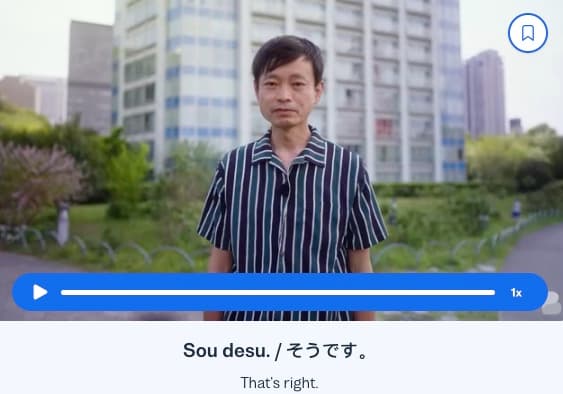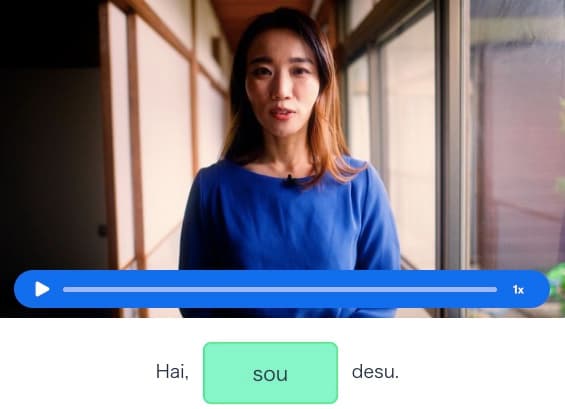I want to learn...
If you’re starting to learn Japanese, one of the first things you’ll want to do is learn how to say a simple yes and no. Fortunately, saying “yes” in Japanese is easy! While saying no in Japanese can be complicated, with yes in Japanese, you can simply use the direct translation.
The short answer: Yes in Japanese
Let’s look at how to say, write, and spell “yes” in Japanese.
How to say yes in Japanese
はい Hai
Hai is the simple, direct word for “yes” and is commonly used in Japanese speech.
How do you write yes in Japanese?
It’s spelled in hiragana with two characters – は (ha) and い (i) – to make はい.
And here’s how to pronounce yes in Japanese
Hai is pronounced much like the English word “hi,” just usually said with a shorter, more confident intonation. Which makes sense, after all: you’re saying yes, not hello!
That said, there are many ways to say yes in Japanese, from the casual to the more formal.
The long answer: There are many ways to say yes in Japanese
Hai is a perfectly good way to say yes in Japanese, but there are plenty of other options if you need to say something more specific – or just want to mix things up a little. Let’s take a look at some other common ways to answer in the affirmative.
1. Ee (ええ)
Meaning: Yes (casual), yeah
Ee is a nice way to say a casual “yes” in Japanese. It’s a variation on hai you can use with friends and family, but that might not be appropriate for work, depending on the situation. It’s an informal way to say yes that is typically used by adults.
2. Un (うん)
Meaning: Mhm, uh-huh, yeah
Even though it’s spelled like “un”, this is usually pronounced more like just a short “nn” and often accompanied by a nod of the head. (Think of the way we say “uh-huh” and “unh-unh” or “mhm” and “mm-mm” in English as a casual yes and no.)
If you’re looking for how to say yes in Japanese in an informal way, un is even more casual than ee. It is more casual than ee and more commonly used by children and younger people.
Worth noting: Since the “no” version of this sound is just a longer “nnn,” this may be easier to learn by watching and listening rather than reading. It depends a bit on intonation and body language, but once you get the hang of it, un can be very handy in casual conversation!
3. Ii desu (いいです)
Meaning: Go ahead, you may, sounds good
Ii desu is a great way to respond to someone asking for permission – for example, if someone asked if they could sit with you, you could answer ii desu. Similarly, it’s sometimes used by parents when kids ask to be allowed to do something. That said, ii desu literally just means “it’s good” or “that’s ok,” so there are plenty of other times where it might come in handy.
4. Sou (そう), sou desu (そうです), and sou desu ne (そうですね)
Meaning: That’s right
Sou desu ne and other variations of the phrase are super common in regular Japanese speech, so learning them will help you understand more and speak more fluently. Sou desu ne is a way to express agreement, literally translating to, “that’s right, isn’t it?”
5. Daijoubu desu (だいじょうぶ です)
Meaning: I’m fine, that’s ok
Daijoubu desu can mean “it’s ok” or “I’m ok.” That means, confusingly, it can be used to say yes, all is well, or a casual “no, thank you,” just depending on the context.
It might be helpful to think of daijoubu desu as less like “yes” and more like saying “I’m good” or “I’m fine.” So, if a server asks if you want another drink and you say daijoubu desu, you’re saying “no, I’m fine,” but if someone asks if the hot tub temperature is to your liking and you say daijoubu desu, you’re saying “yes, I’m fine.”
6. Hai, onegai shimasu (よろしくおねがいします)
Meaning: Yes, please
This is a very polite way to say “yes, please.” It’s a great example of keigo, the more formal mode of Japanese speech that can make Japanese a difficult language to learn. Hai, onegai shimasu translates directly to “yes, please treat me well,” or “please take care of me,” but is equivalent to a very polite “yes, please. ”You’re basically saying that you’re in somebody’s hands.
Onegai shimasu is also commonly used when first meeting someone (as a way of saying nice to meet you, let’s have a good relationship) and to thank someone for a favor (I’m in your hands, thank you in advance). In short, it’s a handy phrase, and you’ll hear it a lot throughout Japanese speech and culture, but its meaning can depend on context.
7. Wakarimashita (わかりました), wakatta (わかった)
Meaning: Got it, understood
Wakarimashita is the formal version of wakatta. Both are iterations of the verb wakaru and mean, loosely, “got it.” It’s a way to say, “yes, I understand” or “yes, I’ll do that”. Wakarimashita is the way you’d say it at work or at school if a superior gives you a task. Wakatta is more something you’d say to a friend, for example, in response to plans. A friend wants to meet Wednesday at 7 at the ramen shop? Wakatta. Got it.
8. Mochiron (もちろん)
Meaning: Of course
Another handy Japanese word, mochiron means “of course” and is used just like you’d use it in English. When a friend asks for a favor or the bartender asks if you want another round, you can say, mochiron.
9. Shouchi shimashita (しょうちしました)
Meaning: Noted, acknowledged and complying
Shouchi shimashita is a polite phrase used almost exclusively at work. It means something like “duly noted” and is sometimes translated as “I understand and will comply.” If a boss hands down a directive and you want them to know you’ve understood and will take appropriate action, you could correctly say shouchi shimashita. On the other hand, if you said it to a friend, it’d sound stiff and out of place.
10. Okkee (オッケー)
Meaning: OK
Last but certainly not least, many Japanese people use okkee to say “OK” in casual speech. It’s a loan word, as you can tell from the use of katakana, and is pronounced just like “OK.” So it’s really just the English word OK, but brought into the Japanese language. In fact, most Japanese people, if writing it in a casual setting, would simply use the English “OK,” even using the Roman alphabet.
Yes and no: Watch out for soundalikes
As you may have noticed, there are a few Japanese responses that can sound very similar, but one means yes, and the other means no.
We talked a little bit about un earlier, but the “no” version of this sound is simply uun (ううん)– a longer, less positive sound, usually accompanied by shaking the head no, waving hands, or other clarifying body language.
Similarly, while you can say yes with ee (ええ) or ii desu (いいです), those words can sound a lot like iie (いいえ), the word for “no.” See, a direct translation of “no” in Japanese is iie, ie, or iya. The sounds can be easy to mix up if you’re not listening closely or paying attention to facial expressions and body language.
As you can probably guess, with all these subtleties, the best thing to do is practice listening and speaking with help from Japanese native speakers to make sure you understand and are understood when you want to say yes in Japanese.
AUTHOR

Emily Duncan
Newlanguages


